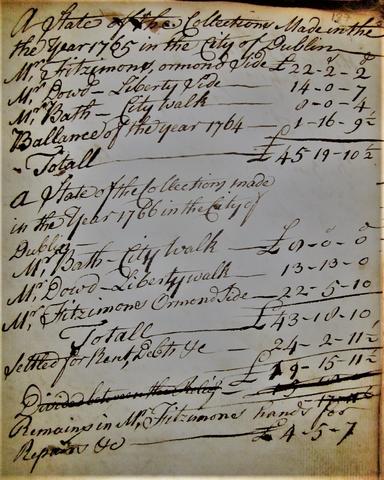Identity area
Reference code
Title
Date(s)
- c.1740-1827 (Creation)
Level of description
Extent and medium
266 pp [pagination added later in pencil]; 21 cm x 16.5 cm; Bound volume; Manuscript
Context area
Name of creator
Repository
Archival history
Immediate source of acquisition or transfer
Content and structure area
Scope and content
The reverse of the fly leaf is annotated: ‘The Very Reverend Murphy’s Book’. This leather-bound book is comprised of distinct entries in several hands. The listing below follows the sequence of entries as found in the volume.
• Yearly accounts of collections made between 1781 and 1807. The accounts commence with a statement that in 1781 ‘we began to bring in the full sum made on the collections, allowing to each of the six gentlemen (for their trouble) who went on the collections five guineas …’. The entries for the yearly collections are listed under location (‘Liberty’, ‘City’, ‘North’), with the names of the collecting friars. These accounts cover pp 3-8.
• An account of street collections made in 1827 is extant on p. 9.
• Register of the names of subscribers towards the rebuilding of the Church Street Chapel. This portion of the volume covers pp 35-161. From internal evidence, it appears that the list of subscribers dates to the mid-eighteenth century. The list of subscribers is alphabetical. An appeal referring to the ‘ruinous condition of the Chapel of Church Street [and] the great poverty of ye … Capucines who attend it’ is extant on p. 35. The appeal seeks subscriptions and affirms that the holy sacrifice of the Mass will be offered once a week to all those persons who contribute to ‘so pious and so great a Charity … particularly those who subscribe halfe a guinea or any sum upwards …’. Large donations given towards the rebuilding of the Church are particularly noted including Messrs Thomas Dillon and Richard Farrel (£10) and a group titled the ‘Gentlemen of the Bachelors’ Club’ (£10).
• Yearly accounts of street collections and rents received between 1760 and 1789. The accounts are extant from pp 182-196. Reference is made to subscribers and occasionally to the location of the collections such as ‘Liberty Walk’, ‘Ormonde Side’, and ‘City Walk’. Rent was received from holdings on Bow Street, on a passage-way running from Bow Street to Smithfield, and on a plot on Church Street.
• A record of community meetings and notices is present between pp 197-202. The entries are from 2 Apr. 1781 to 24 Sept. 1783. The meetings include regulations governing the size of the Capuchin community. One article reads: ‘Whereas by a constant and uniform experience we know that the emoluments accruing from our collections … are not adequate to the maintenance of more than eight gentlemen, we are resolved not to receive or admit a ninth into the chapel’. Other regulations refer to collections to pay the rent of the chapel and other debts, the celebration of masses and the letting of various properties on Bow Street and on Church Street (including a plot ground adjacent to the Chapel for the building of a Charity School). The notices are periodically signed by members of the Capuchin community.
• A note (dated 12 Nov. 1785) referring to the obligation to celebrate twelve masses for the spiritual and temporal welfare of Patrick Sherlock and eight masses for his wife Catherine (in consideration of £20) is made on p. 207. The obligation for this intention is signed by the ‘religious of the Order of St. Francis and of the Chapel of Church Street’: Br. Francis Mary Fitzsimons, Br. John O’Brien, Br. Thomas [Marianus?] Corcoran, Br. Celestine Corcoran, Br. James Leonard, Br. Angel Phelan, … Fr. Silvester Cap. Exdefs.’.
• A note regarding regulations made at a meeting of the ‘religious clergymen of Church Street Chapel’ on 6 Jan. 1789 is made on p. 209. The regulations refer to the penalties imposed upon the clergy for neglecting to celebrate mass ‘at his rotation hour’. The note specifies that the ‘Rev. Messrs Fitzsimmons and O’Brien be exempt from the fine annexed to the omission of evening service on condition that they celebrate mass at any hour on week days’.
The final page of the volume (p. 266) is annotated in a different hand with a list of postulants. It reads:
‘Nicholas now Justin Malone;
Joseph now John Sheridan;
John now Joseph Devereux
James now Patrick Kenny
6th October 1808 –
10 April 1809 ...
May 12th 1809 –
We have received three young men this day as Novices –
The first John McCormick under the name of Stephen
2nd – James O’Connor by and under the name of Thomas
Michael [Roch?] by and under the name of Bernard
The second left us after a few days –
Wade took the habit on the 2nd of June by the name of [left blank]. Mr. J Murphy took the habit on the 19th May by the name of Andrew. Mr Wade made [his] profession on the 4th June 1816’.
Appraisal, destruction and scheduling
Accruals
System of arrangement
Conditions of access and use area
Conditions governing access
Conditions governing reproduction
Language of material
Script of material
Language and script notes
Physical characteristics and technical requirements
The binding has become detached from the text block and a number of pages are loose. The edges of some of the pages are also quite frayed. Very careful manual handling is required.

